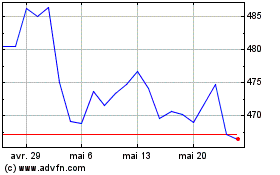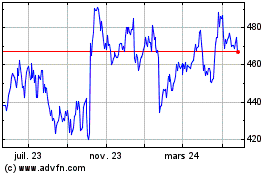Scientists Search for Best Way to Restore Oysters in Chesapeake Bay
03 Août 2019 - 1:59PM
Dow Jones News
By Acacia Coronado | Photographs by Greg Kahn for The Wall Street Journal
Scientists are racing to stem a rapid decline in the oyster
population in Chesapeake Bay.
The number of oysters, a valuable part of the shellfish industry
in the region, has fluctuated and been unreliable since the 1980s.
The amount of market-size mollusks harvested in the Maryland
stretch of the bay fell from about 380,000 bushels in the 2015-16
season to 180,000 bushels in the 2017-18 season, according to state
data.
Water pollution, parasites and overfishing are among the reasons
behind the decline, scientists say. Also, heavy rains can increase
the flow of fresh water into bays, lowering water salinity and
making it uninhabitable for oysters.
"The current population baywide of oysters is estimated to only
be a couple percent of what were here in colonial times," said Will
Baker, president of the advocacy group Chesapeake Bay Foundation,
citing recent studies.
The Chesapeake Bay Foundation is one of several local, state and
national organizations working to restore oyster populations in the
area. One of its goals is to replenish oysters to the bay by
placing hatchery-produced seed oysters in sanctuary reefs.
About 32 million pounds of U.S. oysters worth more than $236.4
million were harvested in 2017, a decrease of nearly 1.5 million
pounds from the previous year, according to the National Oceanic
and Atmospheric Administration. About 15% of the 2017 haul was from
the Middle Atlantic region, which includes the Chesapeake Bay.
In addition to the shellfish industry, oysters are essential to
the estuary ecosystems in which they live because they filter
water, removing excess algae and converting it to food. Oyster
reefs also are a magnet for a variety of other marine species.
The Sustainable Oyster Population and Fishery Act of 2016
required Maryland's Department of Natural Resources, in partnership
with the University of Maryland, to conduct a study and adopt a new
oyster management plan by 2018.
Dr. Michael Wilberg, professor at the University of Maryland
Center for Environmental Science and an author of the state's 2018
oyster stock assessment, said oyster populations tend to oscillate.
In addition to disease, contamination and harvesting, the rate of
oyster reproduction varies. For example, oyster populations
recovered after a dramatic hit from disease in the early 2000s.
The current population and habitat monitoring process costs more
than $7,000 a day and requires sending a professional diver into
dangerous underwater territory, which limits the amount of reefs
that can be assessed. Scientists said because of the time and
monetary cost of getting information, they are unable to
consistently track data from every section of oyster habitat.
"Getting information from that system is very challenging
because we are not underwater creatures," said Allison Colden,
Maryland fisheries scientist with the foundation.
The foundation is working with global aerospace and
defense-technology firm Northrop Grumman Corp. to develop new
remote-sensing technology to track oyster populations and the
health of oyster reefs in the bay. The new process will include
capturing underwater imagery, mapping the reefs and collecting
water chemistry -- without underwater divers.
R. Eric Reinke, chief science officer at Northrop Grumman, said
six teams within the company are competing to come up with the best
new technology, with the goal to start testing in early 2020. The
company, which is based in the Baltimore area, has partnered on
environmental education and preservation efforts for about 15
years.
"We're here to help the CBF reach its goal of planting 10
billion new oysters by 2025," Mr. Reinke said. "We have thousands
of employees in the state of Maryland and consider the Chesapeake
Bay part of our backyard."
Restoration efforts in the past 20 years have included placing
oyster shells into habitats where new oysters can use them to grow
and building concrete columns that reinforce oyster reef
structures, said Doug Myers, senior scientist in Maryland for the
Chesapeake Bay Foundation.
Ms. Colden said once the new technology is ready, one main goal
is to use it to assess what techniques have worked effectively and
to identify which locations in Maryland and Virginia need the most
work.
"This is not a short-term goal, restoring oysters in the
Chesapeake Bay will take a while," Ms. Colden said.
(END) Dow Jones Newswires
August 03, 2019 07:44 ET (11:44 GMT)
Copyright (c) 2019 Dow Jones & Company, Inc.
Northrop Grumman (NYSE:NOC)
Graphique Historique de l'Action
De Juin 2024 à Juil 2024

Northrop Grumman (NYSE:NOC)
Graphique Historique de l'Action
De Juil 2023 à Juil 2024
